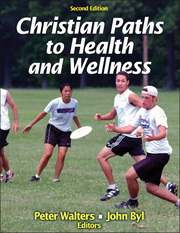Christian Paths to Health and Wellness was written primarily for Christian students just beginning college, but it should work well for homeschoolers in their last few years of high school as well. The second edition of this text was published in 2013 based on up-to-date research. The book is edited by Peter Walters and John Byl, but a number of other authors who are specialists in their fields contribute to the text and continually help keep it up to date.
A primary aim of the book is to motivate students to take responsibility and initiative for maintaining their own health. This is not your usual health textbook. It is much more focused on what it takes to develop a healthy lifestyle.
First-person stories, survey results, biblical perspectives, spiritual applications, self-assessments, and thought-provoking questions are interspersed with information to engage students at a personal level with the material.
The book is divided into four main sections: Understanding Your Wellness and Mission, Accepting and Caring for Your Body, Moving Your Body, and Understanding Your Behaviors.
The first section, Understanding Your Wellness and Mission, builds a framework and goals within which the rest of the book can be applied. The authors discuss Creation, the Fall, and Redemption to help students understand who they are both physically and spiritually. The second of the two chapters in this section helps students come up with a personal mission statement and set goals for their life journey.
Part II, Accepting and Caring for Your Body, has only two chapters. The first is on body image and eating disorders and the second is on weight control. These chapters speak to both men and women.
The goal of Part III is to get students moving on physical workouts. The three chapters in this section cover cardiorespiratory, muscular strength, and flexibility assessment and training. For each of the three areas, it presents assessments that can be done without expensive equipment as well as workouts to improve in all three areas. Students learn some basic physiology along the way, but it is taught within the context of fitness rather than the other way around. In addition to this large section of the text devoted to fitness, Appendix C charts out a three-phase Strength Training Program.
Part IV addresses nutrition, emotional health, sleep habits, and personal relationships under the heading “Understanding Your Behaviors.” As with the rest of the book, the content of these chapters speaks directly to issues experienced by students just beginning college, issues that also affect those in the last few years of high school. This section walks students through self-assessment using the acronym SHAPE for spiritual gifts, heart (values), abilities, personality, and experience. While there is discussion of the positive value of relationships in general, there is no discussion of dating and sexual relationships.
Each chapter concludes with a few review questions plus some application activities. Many of the activities are extensive. For example, Chapter 5 concludes with a number of fitness assessments. Detailed instructions and standards are provided. Every chapter concludes with lists of references, suggested reading, and suggested websites.
The book itself is professionally designed with full-color illustrations. It can be purchased as a printed book or an ebook. Since the book is 8.5” x 11” with some visual layouts that need to be viewed in a larger format, the ebook is likely to work best on a larger screen rather than a small tablet screen.
The print book might need to be used as a consumable book. There are a number of assessments and questionnaires that students are expected to complete, and these are most easily done directly in the book. Also, students trying to develop a lifestyle of fitness are likely to use the book as a guide and reference tool beyond what is required for class. However, there’s another option if you want to avoid having students write in the book. If you sign up for the HK Rewards program with the publisher by subscribing to one or more of their free newsletters, you can receive access to a free copy of the ebook version when you purchase the print version. That would make it easier to print out pages on which students might write.
Teacher resources are available free online, although you need to create an account. Online teacher resources include an instructor guide with a course syllabus, course outline, chapter learning outcomes, answer key, and suggested reading and websites. You also have access to a test bank with questions for creating your own tests as well as PowerPoint presentation materials for those who present the course for a class.
Christian Paths to Health and Wellness is significantly different than most health textbooks in that it expects students to not just learn the material, but to also apply it, especially through a fitness program. In a homeschool context, it should work best for self-motivated students who are able to work through the text independently.









